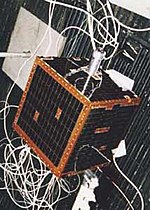cosmos.wikisort.org - Spacecraft
SEDSAT-1 (also known as SEDSAT-OSCAR 33) is a U.S. amateur radio satellite built by students and developed at the University of Alabama in Huntsville (UAH).
 SEDSAT-1 satellite. | |
| Mission type | Communications |
|---|---|
| Operator | AMSAT |
| COSPAR ID | 1998-061B |
| SATCAT no. | 25509 |
| Spacecraft properties | |
| Manufacturer | University of Alabama |
| Launch mass | 35 kg (77 lb) |
| Dimensions | 32.13 cm × 32.13 cm × 35.43 cm (12.65 in × 12.65 in × 13.95 in)[1] |
| Start of mission | |
| Launch date | 24 October 1998, 12:08 UTC |
| Rocket | Delta-7326 D-261 |
| Launch site | Cape Canaveral SLC-17A |
| Orbital parameters | |
| Reference system | Geocentric |
| Regime | Low Earth |
| Eccentricity | 0.03699 |
| Perigee altitude | 547 kilometres (340 mi) |
| Apogee altitude | 1,079 kilometres (670 mi) |
| Inclination | 31.4° |
| Period | 101 minutes |
| Epoch | 24 October 1998[2] |
OSCAR | |
The microsatellite bears the name of one of its sponsoring organizations, the Students for the Exploration and Development of Space (SEDS). It was launched into a low Earth orbit on October 24, 1998 as a Secondary payload with the Deep Space 1 spacecraft using a Delta II rocket at Cape Canaveral Air Force Station, Florida, USA.
History
The satellite was to be built by the partnership between NASA's Marshall Space Flight Center and UAH with the primary objective of testing a newly developed small expendable deployer system developed for NASA's Space Shuttle, while allowing the students to add instrumentation to complete secondary missions after the primary data regarding the deployer's tether system had been captured.[3] After the Tethered Satellite System (TSS-1R) experienced a failure resulting in the ignition of a strong electrical discharge shortly after being deployed from the Space Shuttle Columbia in 1996, the small expendable deployer system was subject to a Space Shuttle safety review that resulted in extensive design and requirements changes.[4] As a result, SEDSAT-1 became a free-flying secondary payload on the Delta II, after securing sponsorship from other governmental and commercial partners.[5]
Mission
The satellite was intended to have a novel link to the internet that would allow amateur radio operators from around the globe to request and receive imagery from the satellite anytime it flew overhead.[6] To this end, the satellite carries two cameras as part of the SEASIS (SEDS, earth, atmosphere, and space imaging system) instrument.[7] SEDSAT-1 also includes instruments which monitor battery performance management and control. After launch, telemetry data was received at the satellite's university led mission control center at the University of Arizona in Tucson, AZ. However, an uplink could never be established and no photographic data could be received from the SEASIS instrument. The telemetry data received from the satellite did allow for some of the battery control experiments to be received, and as of 2013 the satellite is still active.[8]
Frequency
- Downlink: 437.91 MHz
- Mode: 9600 bps FSK[9]
See also
- OSCAR
Bibliography
- Mark W. Maier, Shi-Tsan Wu: SEDSAT-1 lessons learned. In: F.-B. Hsiao (Hrsg.): Microsatellites as research tools. Elsevier, Amsterdam 1999, pg. 365–375.
- Students for the Exploration and Development of Space Satellite. In: NASA Historical Data Book, Volume VII. Government Printing Office, Washington, D.C. 2009, pg. 669–671
References
- Gunter Dirk Krebs. "SEDSat 1 (SO 33, SEDSat-OSCAR 33)". Gunter's Space Page. Retrieved 10 February 2020.
- NASA GSFC. "Telemetry Details". NSSDCA Master Catalog. Retrieved 10 February 2020.
- COSPAR Colloquium on Microsatellites as Research Tools (Tʻai-nan shih, Taiwan) (1997). Auteur. (2014). Microsatellites as research tools proceedings of COSPAR Colloquium on Microsatellites as Research Tools held in Tainan, Taiwan, 14-17 December 1997. Pergamon. ISBN 978-0-444-50196-7. OCLC 881679774.
- Stone, N. H.; Bonifazi, C. (1998). "The TSS-1R Mission: Overview and scientific context". Geophysical Research Letters. 25 (4): 409–412. doi:10.1029/97GL02980. ISSN 1944-8007.
- "Project Information Details". archive.seds.org. Retrieved 2020-02-14.
- "SEDSAT Puts Students Over The Earth". www.spacedaily.com. Retrieved 2020-02-18.
- Bankston, Cheryl Dawn (1994-06-08). "SEDS, earth, atmosphere, and space imaging system (SEASIS)". Space Instrumentation and Dual-Use Technologies. International Society for Optics and Photonics. 2214: 257–268. doi:10.1117/12.177665.
- "SEDSat 1 (SO 33, SEDSat-OSCAR 33)". space.skyrocket.de. Retrieved 2020-02-18.
- N2yo.com. "SEDSAT 1". Retrieved 10 February 2020.
На других языках
[de] SEDSAT-1
SEDSAT-1 (auch SEDSAT-OSCAR 33) ist ein US-amerikanischer Amateurfunksatellit.- [en] SEDSAT-1
Другой контент может иметь иную лицензию. Перед использованием материалов сайта WikiSort.org внимательно изучите правила лицензирования конкретных элементов наполнения сайта.
WikiSort.org - проект по пересортировке и дополнению контента Википедии
